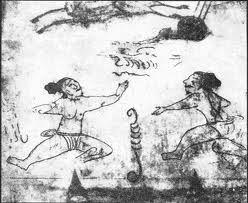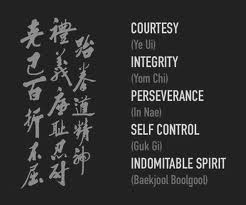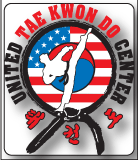
Taek Kyon

The art of Tae Kwon Do combines many aspects such as, physical conditioning, mental training and philosophical study. However, it also has to do with the development of the Tae Kwon Do spirit which carries over into all aspects of a student’s life. In English, the translation of Tae Kwon Do is “the art of kicking and punching.” Tae means “to kick”, Kwon means “to punch” and Do means “art”.
Do in Korean implies a philosophical viewpoint or way of approaching life; or a means by which enlightenment is achieved. This is one of the ultimate aims of the art of Tae Kwon Do. Through rigorous physical training, students of the art seek to improve themselves, physically, mentally, and spiritually.
History of Tae Kwon Do
Tae means “to kick” or “to strike with the foot” Kwon means “fist” or “to strike with the hand”,” and Do means “discipline” or “art.” Together, Tae Kwon Do means “the art of kicking and punching” and is sometimes referred to as “the art of unarmed combat.” Modern Tae Kwon Do today, as developed over the years, is a unique martial art style that incorporates the quick, straight-line movements that characterize many of the various Japanese systems and the flowing circular movements of many Chinese styles. However, more than this, Tae Kwon Do distinguishes itself by its varied and unique powerful kicking techniques.
The practice of Tae Kwon Do dates back to approximately 50 B.C. At the time Korea was divided into three kingdoms, Silla, founded on the Kyongju plain in 57 B.C.; Koguryo, founded in the Yalu River Valley in 37 B.C.; and Baekche, founded in the south-western area of the Korean peninsula in 18 B.C.
There is evidence of the practice of Taek Kyon (the earliest known form of Tae Kwon Do) found in ceiling paintings of the Muyong-chong, a royal tomb from the Koguryo dynasty. These paintings show unarmed combatants using techniques that are essentially identical to modern day Tae Kwon Do. Closer details of the paintings show the use of the knife hand, fist and classical fighting stances that are part of the practice of Tae Kwon Do today.
Although Tae Kwon Do first appeared in the Koguryo kingdom, it is Silla’s warrior nobility, the Hwarang, who are credited with the growth and spread of the art of Tae Kwon Do. Silla was the fist kingdom formed and the smallest and least civilized whose coastline faced constant attack by Japanese pirates. The 19th in line of Koguryo monarchs, King Gwanggaeto answered the appeal for help against the pirates by sending help, and it is believed that Taek Kyon was then first introduced to Silla’s warrior class, which was handed down in strict secrecy to only a few select Sillan warriors by early masters of the art. These warriors became known as the Hwarang. The elite society of the Hwarang-do (“the way of flowering manhood”) was formed and the guiding principles developed of the Hwarang-do education were based on the Five Codes of Human Conduct: 1. Be loyal to your country 2. Be obedient to your parents 3. Be trustworthy to your friends 4. Never retreat in battle and 5. Never make an unjust kill. The art of Taek Kyon was taught along with incorporating the Five Codes of Human Conduct, and became a way of life for these young warriors. Today, these codes are a reflection of the so-called 11 commandments of Tae Kwon Do, used to guide the moral development of students of the art.
Taek Kyon was spread throughout Korea during the Silla dynasty from A.D. 668 to A.D. 935 by traveling Hwarang warriors. During the Koryo dynasty (935-1392), Taek Kyon became known as Subak, and during the reign of King Uijong (1147-1170), it changed from a system designed mainly to promote fitness into a fighting art. The fist book available on the art was written during the Yi dynasty (1397-1907), and promoted the art among the population. Before this, the art was basically restricted to military nobility only. Because of political unrest Subak became fragmented, and its’ practice declined. In 1909 when Japan invaded Korea, Korea’s fighting arts experienced resurgence.
In Korea, Subak/Taek Kyon was kept alive by a number of famous masters of Korean fighting arts.
The fist kwan (“school”) to teach a native Korean style of martial art was opened in 1945 in Yong Chun, Seoul. The dojang was named the Chung Do Kwan. That same year, the Moo Duk Kwan and the Yun Moo Kwan also opened in Seoul. Seven other major schools were formed between 1953 and the early 1960’s, with the three most prominent being the Ji Do Kwan, the Song Moo Kwan, and the Oh Do Kwan. Even though each of these schools claimed to teach traditional Korean martial arts, each one emphasized a different aspect of Tae Kyon/Subak, so various names emerged for their styles such as, Soo Bahk Do, Kwon Bop, Kong Soo Do, Tae Soo Do and Dang Soo Do, as well as traditional Taek Kyon.
Dissension between the various kwans prevented formation of any central regulating board for 10 years. A turning point in Korean martial arts occurred in 1952 during the height of the Korean War. After watching a demonstration by Korean martial arts masters, President Syngman Rhee ordered training in Korean martial arts to all regular military training programs. After the end of the war in 1953, the Korean 29th Infantry Division was responsible for all Taek Kyon training in the Korean Army and on April 11, 1955 a unification of the various kwans under the name Tae Soo Do was accepted by the majority of the kwan masters, who agreed to merge their various styles.
Two years later the name was changed again to what is known today as Tae Kwon Do. Tae Kwon Do was chosen because it accurately describes the nature of the art (comprised of both hand and foot techniques) as well as for its similarity to the early Taek Kyon. Even though most of the kwans merged under this common name, there were a few who resisted, and it is not totally clear which of the original eight merged in 1955, but of those who did not, only Hapkido has remained as a recognized separate art in itself.
The Korean Tae Kwon Do Association was formed on September 14, 1961. On May 28, 1973, The World Tae Kwon Do Federation (WTF) was formed. All Tae Kwon Do activities outside of Korea have been coordinated by the WTF since their formation, and are the only official organization that is recognized by the Korean government as an international regulating body for Tae Kwon Do.
In May 1982, Tae Kwon Do was designated as an official Demonstration Sport for the 1988 Olympic Games in Seoul, Korea. Under the leadership of their coach, Grandmaster Yeon Hwan Park, the United States women’s team won first place and the men’s US team respectfully finished 2nd, topped only by the Korean National Team. In September 1994, Tae Kwon Do was accepted as a full medal sport for the 2000 Olympic Games in Sydney, Australia.
Tae Kwon Do is recognized today as the most widely practiced martial art system in the world with an estimated 30 million practitioners in over 163 countries worldwide.
1. Tae Kwon Do 3rd Ed. by Y.Hee Park, Y.Hwan Park, Jon Gerrard 2009
Tae Kwon Do Code
- Respect each other
- Help each other
- Be honest
- and Always stand by the weak
Tae Kwon Do Tenets
- Courtesy: Consider others before yourself.
- Integrity: Show truth in your actions and words.
- Self-Control: Think before you act and speak.
- Perserverance: Never give up, always keep trying.
- Indomitable Spirit: Face your fears confidently.

Common Commands in TKD
Romanization Hangeul Hanja English
Cha ryeot 차렷 Attention
Gyeong rae 경례 敬禮 Bow
Ba ro 바로 Return
Shi eo 쉬어 At ease (relax)
Hyu shik 휴식 休息 Rest period (break)
Gi hap 기합 氣合 Yell (shout)
Jun bi 준비 準備 Ready
Shi Jak 시작 始作 Begin (start)
Gal ryeo 갈려 Break (separate)
Gye sok 계속 繼續 Continue
Geu man 그만 Finish (stop)
Dwiro dol-a 뒤로 돌아 About face (180 degrees)
Hae san 해산 解散 Dismiss
©2014-2015 JHeightsUnitedTKD All rights reserved
